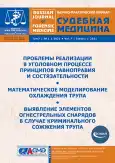К вопросу о терминологии в судебной медицине и соответствии её принятым ГОСТам ножниц
- Авторы: Назарова Н.Е.1,2, Назаров Ю.В.1,2
-
Учреждения:
- Бюро судебно-медицинской экспертизы
- Северо-Западный государственный медицинский университет имени И.И. Мечникова
- Выпуск: Том 7, № 1 (2021)
- Страницы: 36-40
- Раздел: В помощь судебно-медицинскому эксперту
- URL: https://journal-vniispk.ru/2411-8729/article/view/122413
- DOI: https://doi.org/10.17816/fm366
- ID: 122413
Цитировать
Полный текст
Аннотация
Актуальность. Терминология, используемая при производстве судебно-медицинских экспертиз, должна трактоваться судебно-медицинскими экспертами, работниками следственных органов и врачами иных специальностей однозначно и являться основой их взаимопонимания. Исследование одежды и обуви, а также повреждений на них является важной частью работы эксперта. Однако при наличии судебно-медицинской и криминалистической литературы, посвящённой этому вопросу, в настоящее время наблюдается всё более возрастающий недостаток учебно-методических изданий, освещающих современные терминологические определения. В процессе производства судебно-медицинских экспертиз вещественных доказательств эксперт нередко сталкивается со следообразующими предметами (или их частями), которые он затрудняется назвать или описать без ущерба для однозначной трактовки. Обращает на себя внимание игнорирование в практической судебно-медицинской деятельности названия областей ножниц. Даже с устоявшимся понятием «бранши ножниц» в экспертной практике имеются разные точки зрения. Цель исследования — обозначение терминологии, которая определяет стандарты, обеспечивающие взаимопонимание между специалистами разных областей, для закрепления однозначных терминов и определений на уровне знаний и понятий современной науки. В результате проведённого исследования авторы приходят к выводу, что для снижения риска различного понимания терминов (в том числе немедицинского характера) необходимо обращаться к Государственным стандартам Российской Федерации (ГОСТам). Как пример, в статье приводятся термины действующего Государственного стандарта 51268-9, где основными следообразующими элементами ножниц указываются ножи, а не бранши, понятия «бранши» данный ГОСТ не содержит. Заключение. Стандартизация и приведение судебно-медицинских терминов к соответствующим ГОСТам при производстве судебно-медицинских экспертиз не только повысит их качество и информативность для следственных органов, но и исключит разночтения в терминологии между работниками правоохранительных органов, судебно-медицинскими экспертами и врачами других специальностей.
Ключевые слова
Полный текст
Открыть статью на сайте журналаОб авторах
Наталья Евгеньевна Назарова
Бюро судебно-медицинской экспертизы; Северо-Западный государственный медицинский университет имени И.И. Мечникова
Email: na532z@yandex.ru
ORCID iD: 0000-0002-2020-0291
SPIN-код: 6821-6095
Россия, Санкт-Петербург
Юрий Викторович Назаров
Бюро судебно-медицинской экспертизы; Северо-Западный государственный медицинский университет имени И.И. Мечникова
Автор, ответственный за переписку.
Email: naz532@yandex.ru
ORCID iD: 0000-0002-4629-4521
SPIN-код: 2390-8227
Scopus Author ID: 57137901000
д.м.н.
Россия, Санкт-ПетербургСписок литературы
- Буромский И.В., Клевно В.А., Пашинян Г.А. Судебно- медицинская экспертиза: Термины и понятия: словарь для юристов и судебно-медицинских экспертов. Москва: Норма, 2006.
- Клевно В.А., Бойко Ю.Л., Филиппов М.П., Клевно Р.В. Медико-криминалистический терминологический словарь (Основные понятия и определения, используемые в судебной медицине и криминалистике). Барнаул: Изд-во Барнаульского юридического института, 2003.
- Пашинян Г.А., Завальнюк А.X. Словарь судебно-медицинских терминов. Ижевск: Экспертиза, 1996. 130 с.
- Национальный стандарт Российской Федерации. Судебно- трасологическая экспертиза. Термины и определения. Москва: Стандартинформ, 2018.
- Исаков В.Д., Бабаханян Р.В., Дыскин Е.А. и др. Судебно-медицинское описание повреждений одежды. Учебно-методическое пособие / Под ред. В.Д. Исакова. Санкт-Петербург, 1999. 163 с.
- Кустанович С.Д. Исследование повреждений одежды в судебно-медицинском отношении. Москва, 1965.
- Тахо-Годи X.М. Криминалистическое исследование одежды. Москва, 1971.
- ГОСТ Р 51268-99. Группа У17. Государственный стандарт Российской Федерации. Ножницы. Общие технические условия. Режим доступа: http://docs.cntd.ru/document/1200027241. Дата обращения: 15.01.2021.
- РМГ 19-96. Рекомендации по основным принципам и методам стандартизации терминологии. Режим доступа: http://docs.cntd.ru/document/1200044770. Дата обращения: 15.01.2021.
- Кононов Н.В., Фетисов В.А., Назаров Ю.В. Проблемные вопросы судебно-медицинской экспертизы смертельной травмы, причиненной современным маломерным водным транспортом // Судебно-медицинская экспертиза. 2020. Т. 63, № 2. С. 47–51. doi: 10.17116/sudmed20206302147
- Назаров Ю.В., Толмачев И.А., Божченко А.П. Судебно- медицинская характеристика патронов травматического действия калибра 18×45 и 18,5×55 мм комплекса ОСА // Судебно-медицинская экспертиза. 2020. Т. 63, № 5. С. 30–33. doi: 10.17116/sudmed20206305130
- Божченко А.П., Назаров Ю.В. Определение понятия «авиационная травма» // Судебная медицина. 2019. Т. 5, № 1s. С. 59–60. doi: 10.19048/2411-8729-2019-5-1S-59-60
- Назаров Ю.В., Божченко А.П. Диагностическое значение диатомовых водорослей при медико-криминалистических альгологических исследованиях // Судебная медицина. 2019. Т. 5, № 1s. С. 161–162. doi: 10.19048/2411-8729-2019-5-1S-161-162
- Божченко А.П., Теплов К.В., Назаров Ю.В. Дерматоглифический метод определения пола по отпечаткам пальцев ног в практике идентификации разрушенных тел // Судебная медицина. 2019. Т. 5,. № 1s. С. 179–180. doi: 10.19048/2411-8729-2019-5-1S-179-180
- Назарова Н.Е. К вопросу об идентификационных признаках ножниц при исследовании повреждений на биологических тканях // Судебная медицина. 2019. Т. 5, № 1s. С. 156. doi: 10.19048/2411-8729-2019-5-1S-156
- Назарова Н.Е. К вопросу о решении задач по определению вида примененных ножниц // Судебная медицина. 2019. Т. 5, № 1s. С. 156–157. doi: 10.19048/2411-8729-2019-5-1S-156-157
Дополнительные файлы







